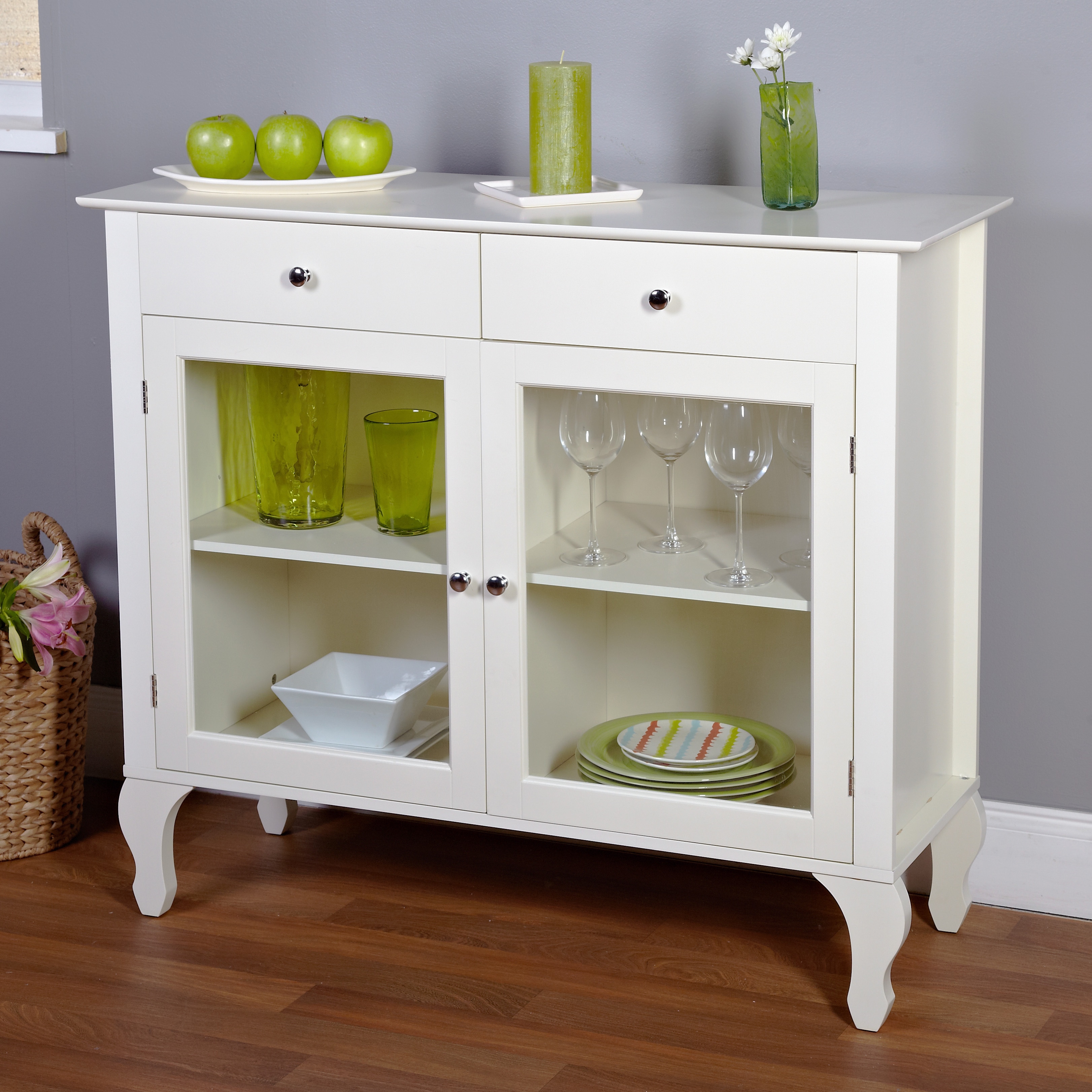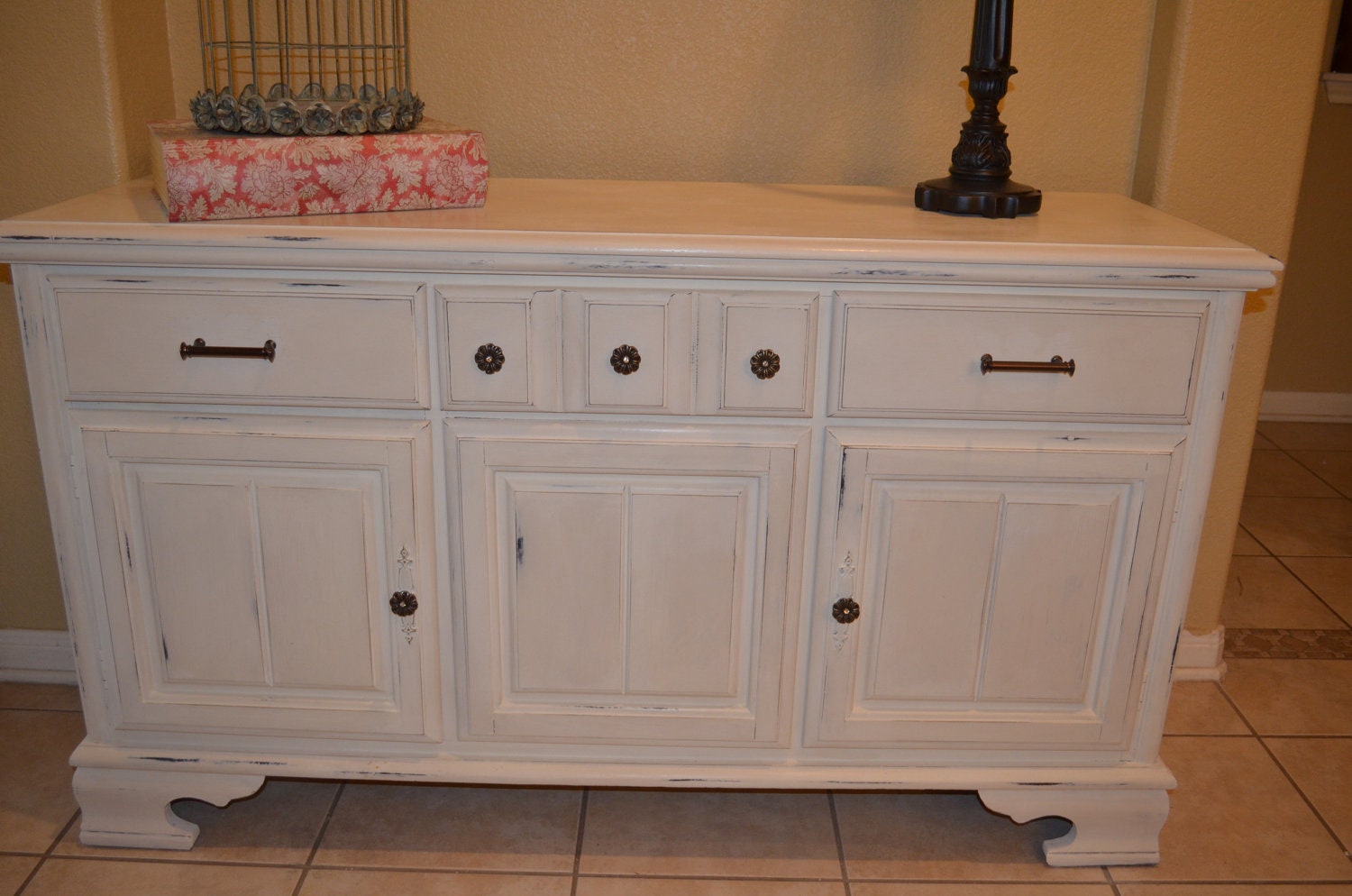Historical Context and Styles of Antique White Buffet Cabinets

The evolution of the buffet cabinet, a staple of dining rooms for centuries, reveals a fascinating interplay between functionality, evolving aesthetics, and the availability of materials. While often associated with darker wood tones, the incorporation of white finishes, particularly in antique pieces, offers a unique perspective on design trends and craftsmanship across different eras. The use of white, often achieved through paint or specialized finishes, highlights the cabinet’s form and details, creating a sense of lightness and elegance that contrasts with the more somber palettes frequently seen in antique furniture.
Antique white buffet cabinet – The popularity of white as a finish fluctuated throughout history, influenced by prevailing design movements and technological advancements in paint production. Early examples might feature a whitewash or limewash, creating a more rustic and uneven finish, whereas later pieces would boast a smoother, more uniform white coat, reflecting improvements in paint technology. The choice of white also interacted with the prevailing decorative styles of each era, resulting in a wide variety of designs and aesthetic expressions.
Victorian Era Buffet Cabinets
Victorian-era buffet cabinets (roughly 1837-1901) often featured ornate carvings, elaborate moldings, and dark, richly grained woods like mahogany or walnut, sometimes accented with painted details. While solid white was less common than darker stains or polychromy, white was used as an accent color on certain details or as part of a multi-colored scheme. The overall aesthetic was opulent and detailed, reflecting the Victorian taste for grandeur and craftsmanship. The hardware was typically substantial, featuring brass or ornate cast iron pulls and hinges.
Art Deco Buffet Cabinets
Art Deco (1920s-1930s) buffet cabinets showcase a stark contrast to their Victorian predecessors. Clean lines, geometric shapes, and a streamlined aesthetic defined this period. White, often used in lacquer finishes, emphasized the sleekness and modernity of the design. Materials included exotic veneers and inlaid woods, highlighting the cabinet’s form rather than obscuring it with excessive ornamentation. The hardware was typically simple, with chrome or brushed nickel accents complementing the minimalist style. The use of white provided a sharp contrast to the darker wood veneers, creating a sophisticated and elegant look.
Mid-Century Modern Buffet Cabinets
Mid-century modern (roughly 1933-1965) buffet cabinets reflect a shift towards functionality and minimalist design. White finishes were frequently used, often on lighter woods like birch or pine, to create a sense of airiness and openness. Clean lines and simple forms were emphasized, with a focus on functionality and practicality. Hardware was often minimal, with simple metal pulls or knobs, often in brass or chrome. Some pieces incorporated unique features such as tapered legs or integrated storage solutions. The use of white in this era often helped to brighten mid-century modern interiors, which frequently featured a neutral color palette.
Materials and Construction Techniques
The materials and construction techniques used in antique white buffet cabinets varied significantly across different eras. Early pieces might utilize traditional joinery techniques, such as mortise and tenon joints, while later pieces might incorporate more modern methods like doweling or glued joints. The choice of wood also influenced the cabinet’s overall aesthetic and durability.
| Era | Common Wood | Hardware Style | Notable Features |
|---|---|---|---|
| Victorian | Mahogany, Walnut, Oak | Ornate brass or cast iron | Intricate carvings, elaborate moldings, often dark stained |
| Art Deco | Exotic veneers, lacquered wood | Simple chrome or brushed nickel | Geometric shapes, streamlined design, often white lacquer finish |
| Mid-Century Modern | Birch, Pine, Teak | Minimalist metal pulls or knobs | Clean lines, simple forms, functionality emphasized |
Identifying and Appraising Antique White Buffet Cabinets

Distinguishing genuine antique white buffet cabinets from reproductions requires a keen eye for detail and a thorough understanding of construction techniques and stylistic elements prevalent during different historical periods. This involves examining various aspects of the piece, from its materials and construction to its overall aesthetic. Accurate appraisal, in turn, depends on a careful assessment of these characteristics alongside market trends and comparable sales.
Characteristics Distinguishing Genuine Antiques from Reproductions
Authentic antique white buffet cabinets often exhibit subtle but significant differences compared to modern reproductions or imitations. Genuine antiques typically display signs of age and wear, including variations in the wood’s finish, minor imperfections in the joinery, and the presence of old hardware. Reproductions, conversely, often aim for a flawless, pristine appearance. Look closely at the wood grain—antique pieces will show natural variations and aging that cannot be perfectly replicated. Examine the joinery; antique construction methods often differ from modern techniques, potentially showing hand-cut dovetails or mortise and tenon joints, while reproductions might utilize more efficient, machine-made joinery. The hardware is another key indicator; antique hardware will often show signs of age and patina, unlike the often-perfect, new-looking hardware on reproductions. Finally, consider the overall “feel” of the piece; an antique often possesses a weight and solidity that a modern reproduction may lack.
Factors Influencing the Value of Antique White Buffet Cabinets
Several factors significantly influence the value of an antique white buffet cabinet. Rarity plays a crucial role; a cabinet from a lesser-known maker or a unique design will command a higher price than a more common piece. The condition of the cabinet is paramount; a well-preserved piece in excellent original condition will be far more valuable than one requiring significant restoration. The maker’s reputation also impacts value; renowned cabinetmakers, like those associated with specific historical styles or regions, often see their work fetch higher prices. Finally, the style of the cabinet influences its value; highly sought-after styles, such as those from the Victorian era or the Arts and Crafts movement, will generally command higher prices than less popular styles. For example, a rare buffet from a prominent 19th-century American maker in excellent condition might fetch tens of thousands of dollars, while a more common, mass-produced piece in fair condition might sell for a few hundred.
Assessing the Condition of an Antique White Buffet Cabinet
A thorough condition assessment is vital for determining an antique white buffet cabinet’s value and restoration needs. Examine the cabinet’s structure for any signs of damage, such as cracks, loose joints, or warping. Inspect the finish for scratches, chips, or areas of wear. Note the presence of any repairs or previous restorations. Check the hardware for missing or damaged pieces. Assess the overall level of original paint or finish remaining. Common signs of wear and tear include scratches, water stains, minor woodworm damage, and loose or missing hardware. Restoration techniques can range from simple cleaning and polishing to more extensive repairs, including wood repair, refinishing, and hardware replacement. Minor repairs, if expertly executed, can enhance value, while extensive restorations may negatively impact value depending on the quality of the work. For example, a small scratch might be easily touched up, while extensive woodworm damage may require significant intervention, potentially lowering value if not handled professionally.
Reputable Sources for Authenticating and Appraising Antique Furniture
Several resources can assist in authenticating and appraising antique furniture. It’s crucial to utilize multiple sources to obtain a well-rounded assessment.
- Experienced Antique Dealers: Reputable antique dealers possess extensive knowledge and experience in identifying and valuing antique furniture. They can often provide authentication and appraisal services.
- Auction Houses: Major auction houses often have specialists who can authenticate and appraise high-value antique furniture. Their expertise and access to comparable sales data can provide valuable insights.
- Appraisers specializing in Antiques: Professional appraisers specializing in antique furniture can offer formal appraisals, often required for insurance or estate purposes. Ensure the appraiser holds relevant qualifications and experience.
- Antique Furniture Societies and Associations: These organizations often offer resources and expertise related to antique furniture authentication and appraisal.
- Museum Curators and Conservators: For particularly valuable or significant pieces, consulting with museum curators or conservators can provide expert authentication and assessment.
Restoration and Care of Antique White Buffet Cabinets

Maintaining the beauty and value of an antique white buffet cabinet requires a delicate balance of careful cleaning, informed restoration techniques, and proactive environmental protection. Ignoring these aspects can lead to irreversible damage, diminishing both the aesthetic appeal and the historical significance of the piece. This section details appropriate methods for preserving your antique cabinet for years to come.
Cleaning Methods for Antique White Buffet Cabinets
Regular cleaning is crucial for preventing the accumulation of dust, grime, and other contaminants that can dull the finish and potentially damage the wood. Avoid harsh chemicals and abrasive cleaners, which can strip the paint or varnish and scratch the surface. Instead, opt for gentle, pH-neutral cleaning solutions. A soft, slightly damp cloth is often sufficient for routine dusting. For more stubborn stains, a solution of mild dish soap and lukewarm water, applied sparingly and wiped immediately, is generally safe. Always test any cleaning solution on an inconspicuous area first to ensure it doesn’t damage the finish. After cleaning, dry the surface thoroughly with a soft, clean cloth to prevent watermarks.
Restoration Techniques for Damaged Antique White Buffet Cabinets
Scratches, cracks, and loose joints are common problems with antique furniture. Minor scratches can often be buffed out with a specialized furniture polish or wax. Deeper scratches may require touch-up paint, carefully matched to the existing finish. For cracks, wood glue is often effective, but professional intervention may be necessary for significant damage. Loose joints can be tightened using wood glue and clamps, ensuring proper alignment before allowing the glue to dry completely. Remember, attempting complex repairs without experience can lead to further damage. Consider consulting a professional furniture restorer for significant structural issues.
Refinishing Antique White Buffet Cabinets
Refinishing an antique white buffet cabinet is a significant undertaking and should only be attempted if you possess the necessary skills and patience. It involves several steps: First, the old paint or varnish must be removed, usually through chemical stripping. This process requires careful ventilation and the use of appropriate safety gear, such as gloves and a respirator. Once the old finish is removed, the wood must be sanded smooth, taking care not to remove too much material. Then, the wood may need to be primed before applying new paint or varnish. Multiple coats may be required, each allowing sufficient drying time between applications. Finally, the cabinet should be waxed or sealed to protect the new finish. This process is time-consuming and requires meticulous attention to detail.
Protecting Antique White Buffet Cabinets from Environmental Factors
Environmental factors, particularly humidity and sunlight, can significantly impact the condition of an antique white buffet cabinet. Fluctuations in humidity can cause wood to expand and contract, leading to warping or cracking. Direct sunlight can fade the paint or varnish over time.
To protect your antique white buffet cabinet, maintain a stable indoor climate with moderate humidity levels. Avoid placing the cabinet in direct sunlight or near heat sources. Use UV-filtering window treatments to minimize sun exposure. Regularly inspect the cabinet for any signs of damage and address any issues promptly.
